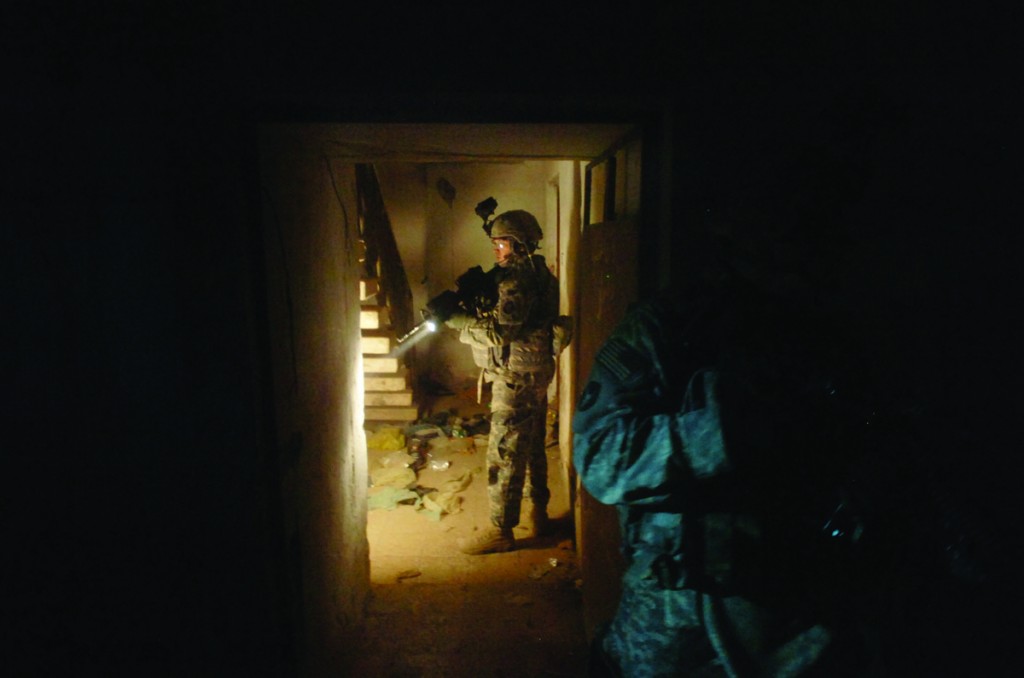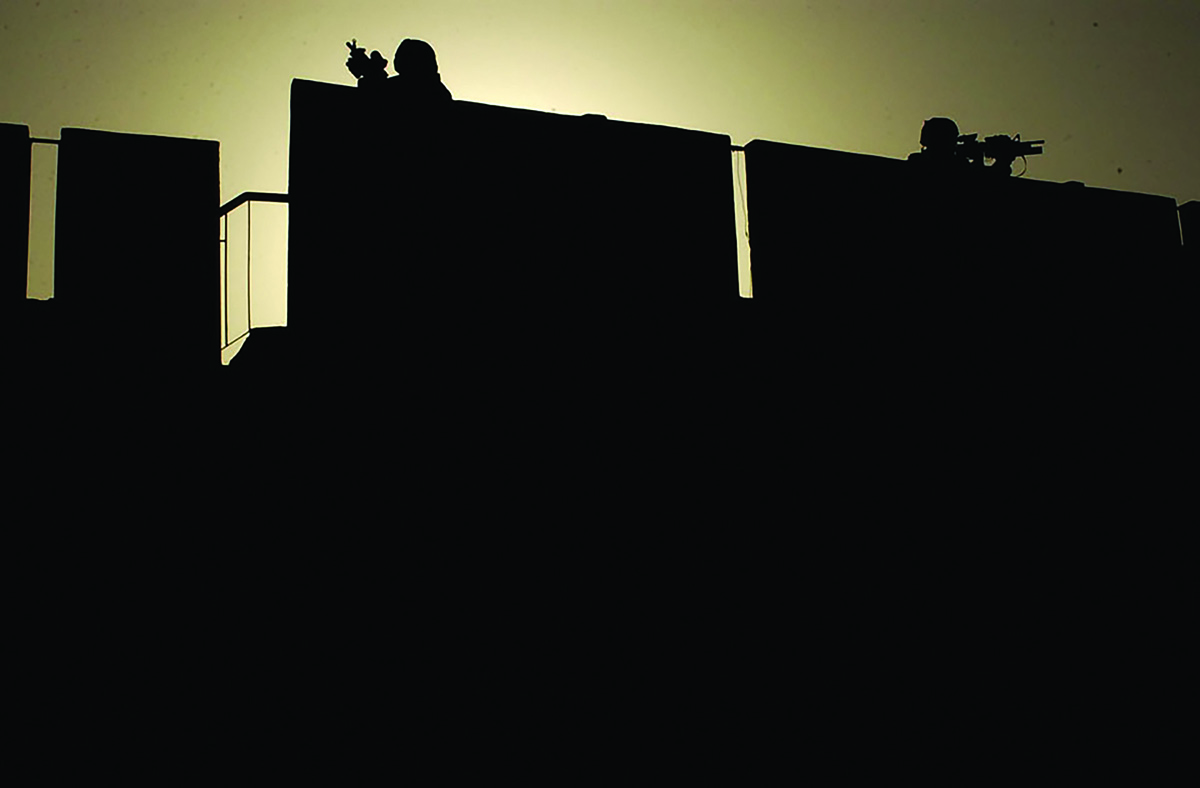When a warrior can’t go it alone
by Neil Caudle

A CH-47 Chinook helicopter flies over Kabul, Afghanistan, June 4, 2007. DoD photo by Cherie A. Thurlby.
It’s their job to go where no one should have to go. To see what no one should have to see. To do what no one should have to do. And afterward, if they’re lucky, they get to come home.
But for some, that last, lucky step turns out to be the hardest one to handle. Because they haven’t spent months or years decompressing from the terrifying depths of combat, from the loss of their buddies. They haven’t spent months or years training for the day when they tumble back into the slipstream of what used to seem normal and safe but no longer does: life at home.
On camera, a soldier with the rank of specialist in the army talks about his return from Afghanistan:
When I first got back I was in a state of denial. It hadn’t really hit me that my buddies were really gone. I drank heavily… First it was only on the weekends, on leave, and then it was almost an everyday thing. When we realized that it was a problem, that it was interfering with work, we started to really see the symptoms of PTSD: not sleeping, not eating, fits of anger, nightmares, flashbacks…
Tom Britt has heard versions of this story many times. As a captain, he served as a research psychologist assigned to the Walter Reed Army Institute of Research, first in Heidelberg, Germany, and then in Silver Spring, Maryland. After he left the army and found his way into academia, he spent two decades studying the mental health of soldiers. He has edited two books and a four-volume series on military psychology. And most recently, he’s been evaluating a new kind of training program designed to help military units support soldiers who need help with mental health.
The project, he says, is pushing him onto new ground.
“After you’ve done academic research for years you start to say, ‘Well, you know I’m contributing to the scientific literature, but am I really doing anything to help anyone?’” he says. “And so when this opportunity came up, it was something I wanted to do, but I was stepping outside of my comfort zone. I think everyone who’s been working on the project realizes how difficult it is to design training that will change attitudes and change the climate of units. It requires a whole different skill set.”
That’s because the attitudes Britt and his team want to change are probably as old as warfare itself.

Tom Britt: Before the training began, many soldiers took a dim view of treatment. “The assumption was that you’re going to go to mental health, get put on medication, and be a zombie, and you won’t be able to do your job.” Photo by Patrick Wright.
The slaps felt ’round the world
In August of 1943, General George C. Patton visited U.S. Army field hospitals in Sicily and, in two separate incidents, slapped, threatened, and condemned as cowards shell-shocked young privates he found among the wounded. When General Dwight Eisenhower learned about the incidents, he relieved Patton of command of the Seventh Army and ordered him to apologize.
Patton’s tirades, eventually reported in the press, made him infamous back home, but his hostility toward soldiers with mental illness was pretty much the norm. Many of Patton’s fellow officers saw no problem with his attitude, and soldiers cheered his old-school toughness. In the military culture of Patton’s day, it was common to dismiss any soldier complaining of “battle fatigue” or “nerves” as a coward, a shirker, or a weakling.
Times have changed. The army today officially recognizes post-traumatic stress disorder and various other mental health problems as legitimate, treatable ailments that can happen to anyone, no matter how dedicated or courageous. The military produces public service announcements to air this message, and leaders go on the record to acknowledge that they themselves have received mental health treatment, and that there was nothing weak or shameful about it.
And yet, down the ranks, where young recruits strap on their Kevlar and venture out to face the enemy, the message doesn’t always come through.
“There is this kind of sense that the climate has improved, and it probably has,” Britt says. “But we saw in our qualitative research, when we did focus groups of soldiers of different ranks, that this stigma is alive and well.”
Learning from the “loony line”
As a captain in the army during the late 1990s, Britt was assigned to help evaluate soldiers coming back from deployment in Bosnia, to examine them for signs of the kinds of mental health problems that plagued many soldiers who returned from Desert Storm. Britt and others developed screening instruments, medical and psychological, and if the soldiers scored above a certain cutoff, they had to talk to either a medical professional or a psychological professional, with a separate queue for each.
“It quickly became apparent which line a soldier was in,” Britt recalls. “If you were in the psychological line, soldiers would say, ‘Oh, you’re in the loony line; they’ll take your weapon…’ There was this visible stigma associated with being in that particular line. So that got me interested in the topic of stigma.”
In one of Britt’s training videos, an earnest young specialist talks about his own dread of shame, when he first went to counseling:
I went in there with the stigma that mental health treatment was something you did not want to get because you kind of get shunned by your peers or subordinates, because they find out, “That guy’s going to mental health, so he’s got to be crazy.”
For many young soldiers, a tough guy persona goes with the job: Never show weakness; never admit you need help. They fall into the habit of concealing their problems, even from themselves. Very often, when a deployment is over and the soldier is back among family again, it’s the spouse, a parent, or a close friend who detects the fault lines of illness and pushes the soldier to get help.
But too many soldiers, Britt says, put off getting help until something catastrophic happens—a broken marriage, for instance, or an arrest for driving drunk. On camera, a specialist puts it this way:
After a failed marriage and… hearing it from people on the outside, civilians, I knew that I needed to get help.
Ideally, Britt says, you’d help the soldier find treatment before his or her life or career hit the ditch. But how do you root out a stigma so thoroughly entrenched?
For one thing, Britt says, you don’t stand at a lectern with a laptop full of PowerPoint slides and begin to hold forth, classroom style. If you’re talking to warriors whose job it is to rise before dawn, march fifteen miles humping a sixty-pound backpack, traverse a snaky forest during land navigation, and finish the afternoon with a harrowing live-fire exercise, the last thing they’ll need is a classroom, a lecture, and a fusillade of bullet points. When Britt’s team asked the soldiers themselves what kind of training they wanted, he says they told him emphatically, “We don’t want any PowerPoint presentations. We’re sick of being PowerPointed to death.”
Peer-to-peer training
So the training, as Britt’s team conceived it over four years of careful study funded by the Department of Defense, uses videotaped interviews from soldiers and their unit leaders who describe their experiences with mental health treatment—the symptoms of their illness, the barriers and fears they had to overcome to seek help, what to expect from treatment (there is no leather couch), and the results. In randomly assigned squads of ten or so soldiers each drawn from two battalions, trainees in the experimental group watch the videos, discuss the issues, and think about specific actions the unit can take to better support soldiers who need treatment. (In the control group, the participants only respond to a survey.) The model Britt’s group has developed for training reflects not only the findings of research but the realities of soldiers’ allegiance to their fellow squad members. Very often, Britt says, soldiers learn best from their peers.
Separately, the researchers also train the squads’ leaders, noncommissioned officers—NCOs. As one staff sergeant puts it, his duty is to place his soldiers’ needs above his own:
We go to horrible locations around the world, and we’re charged with having to bring home our brothers and sisters in arms home to their families safely. That’s our job. We can’t let that go, here on the home front. So as soon as you identify that there is a problem, or somebody is carrying a burden that they don’t need to be carrying, or that they don’t have any control over and they can’t dismiss, it’s your job as a leader, it’s your job as a soldier, it’s your job as a fellow human being, to take immediate action on that and assist anyone in receiving the help they need.
Before and immediately after the training, Britt’s team assesses the soldiers’ and leaders’ knowledge of mental health issues, along with their perceptions about stigma and barriers to treatment. That way, Britt says, the researchers can tell if the training is having an immediate effect. Initial results suggest that those soldiers and leaders receiving the training show better knowledge of mental health issues, more positive attitudes toward mental health treatment, and less negative perceptions of soldiers who get treatment. Three months later, the team returns to conduct another assessment, to see if the effects persist.

What every soldier needs: someone who has his back. Here, U.S. Army soldiers search for weapons caches during a night operation in Baghdad, Iraq. DoD photo by Staff Sgt. Jon Soucy.
Sweating bullets
All of this takes time, not only for the researchers but for the soldiers involved. And time, on a busy military base, is hard to find. How did Britt manage to clear schedules through the chain of command? Has he had good cooperation from the army brass?
He smiles. “Yes, but it’s effortful.”
A contact at Walter Reed introduced him to a division surgeon, and that opened some doors. In the early days, Britt drove down to the base many times and briefed the leaders, if and when they hadn’t been called away to more urgent business. He recalls the day when he at last pitched his project to the colonel in charge.
“It’s fortunate that I was in the army,” Britt says, “so I know how to talk to commanders. But when we briefed the brigade commander he didn’t show any facial expressions during the entire briefing. So I was kind of sweating bullets and wondering, ‘Okay, does he think this is worthwhile, or am I going to get done with this and he’s going to say, “This is where it ends”?’ But after I was done, he said, ‘Just tell me what you need to make this happen.’”
The meetings didn’t stop there. Britt’s team still had to convince the battalion commanders and their noncommissioned officers that the project was worth their time. “So it definitely takes a lot of work that would not be involved in just analyzing data sets that had been collected through some other method,” Britt says.
It’s a complex project with many moving parts, but Britt has recruited help from three colleagues—Cynthia Pury and Heidi Zinzow in psychology and Mary Anne Raymond from marketing—and several graduate students in the Industrial/Organizational Psychology doctoral program, including Kristen Jennings, Janelle Cheung, and Anna McFadden. Raymond’s expertise with focus groups enabled the team to conduct an early round of qualitative research that uncovered soldiers’ preferences and attitudes, a key step in designing the training. With guidance from Britt, Pury, and Zinzow, graduate and undergraduate students collect and analyze results from assessments and track themes that arise during training.
Doubting the meds
One of the themes that emerged from the early focus groups with more prominence than expected involves the use of medications. “It was clear through the qualitative work that attitudes toward psychotropic medications were very negative,” Britt says. “The assumption was that you’re going to go to mental health, get put on medication, and be a zombie, and you won’t be able to do your job.”
Some soldiers also expressed doubts that a squad member under treatment could be trusted to “have my back” in a fight.
Neither of these concerns about medication reflects the reality of modern, effective treatment, Britt says, so the team added new measures in the assessments and new topics for the training.
A specialist relates his own experience this way:
Being on the proper medication, my anxiety level has been reduced tremendously. I’m not living day-to-day anymore. I’m doing more future planning. I’m back to work, I’m doing what I love to do, I’m helping soldiers, training soldiers. I’m not being selfish anymore.
As he speaks these words on camera, the soldier’s bearing is calm and rock-steady, and nothing about him seems weak. In fact, he appears to exude a kind of courage—the kind it takes to admit that he needed help and got it, for the sake of himself, his unit, and all the other people in his life.
Britt and his colleagues, Cynthia Pury, Charles Starkey, and Heidi Zinzow, have written about this kind of psychological or moral courage, a quality Pury, Britt, and their colleagues find apparent in many of the soldiers who seek help. “There’s the sense that even though there might be some stigma, and even though I might face personal distress when I’m working through my problems, I’m going to show the courage to get treatment,” Britt says.
Resilience and the team
Courage of all kinds, Britt says, is likely to be stronger when it’s associated with what he calls resilience, the toughness required to withstand hardship and adversity. Britt, who along with Robert Sinclair edited a book about resilience in soldiers, has long studied the factors that tend to build it up or tear it down. Sergeants in boot camp build resilience by gradually “inoculating” soldiers against hardship, Britt says. But the biggest factors in resilience may be soldiers’ confidence that they have a measure of control over their fate, because they are well trained and prepared, and that their mission has meaning and value.
“Soldiers who believe that their work is meaningful and significant are much less likely to show mental health problems in the face of stressful or traumatic events,” Britt says. “But if you’re in combat somewhere and you’re not well trained, and you don’t know what you’re doing there, and you have a negative attitude about the mission, then that really serves as a major predictor of soldiers who are going to have mental health problems when they get back.”
The bottom line: Don’t ask soldiers to fight for no good reason. And if they must fight, make sure they have the training, equipment, and support they need to feel prepared.
But even with the noblest cause and the best preparation, a soldier deployed into combat will almost inevitably face scary, chaotic unknowns. Most rely on their teammates to help them survive the crucible, to have their backs. So courage and resilience, as Britt sees it, are not just attributes of an individual. They also arise within the group, from the comradery and cohesion that makes each member stronger.
“Over all the military operations, unit cohesion emerges as probably the best predictor of whether soldiers are resilient in the face of traumatic events they encounter in combat and other operations,” Britt says.
That’s why his research and training have focused on the basic military unit, the squad, which is also a soldier’s foremost peer group and social support network. To reduce the stigma and improve the climate for mental health, Britt says, you have to go straight to the heart of the matter, the squad. You have to make it safe for the soldiers, as individuals and members of a team, to seek the help they need.
In short, you have to have their backs.

U.S. Army soldiers pull security on the roof of a house in Baghdad, Iraq, May 6, 2007. Even for those lucky enough to come home safe and sound, the fighting may haunt them and disrupt their lives, unless they find the courage and counsel they need to get help.
Thomas Britt and Cynthia Pury are professors of psychology; Heidi Zinzow is an associate professor of psychology; and Mary Anne Raymond is chair and professor of marketing, all in the College of Business and Behavioral Science. Clemson Broadcast Productions produced the videos used in the training. Cadre from the Clemson ROTC department provided feedback on the leader and unit training.


